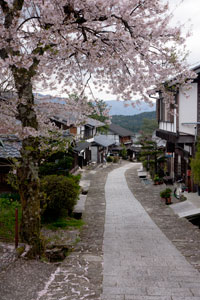
November 1 – December 12, 2012
The Nakasendo was one of the major travel roads in Japan, established during the governance of the Tokugawa Shogunate in the Edo period (17th–19th century) which linked Edo (modern-day Tokyo) and Kyoto via Kiso. Kucharski, a Canadian diplomat, lived almost alongside the Nakasendo when he and his wife Hideko were first married.
The Kucharskis lived in Itabashi, on the outskirts of Tokyo, which used to be one of the post towns on the Nakasendo route. Encountering many preserved signs and references to the Nakasendo in his neighbourhood, Kucharski developed an interest in various aspects of this travel road, such as transportation, culture, politics, trade, and commerce. He became especially fascinated by the Edo and Meiji eras, in particular, the opening of Japan in the 1850s and the subsequent arrival of foreigners who traveled and wrote about early modern Japan.
Firstly, Kucharski’s research led him to build a collection of rare, late 19th century books written in English by foreign residents in Japan, including travel books that describe the Nakasendo and other routes. Secondly, Kucharski’s talent and skill as a photographer enabled him to document the current status of the old travel scenes. When the Nakasendo goes through the Kiso Valley, the route is traditionally called Kisoji – the travel road of Kiso. This is the historical area where the most well-preserved travel road villages can be still found, and where one of the first street-scene preservations was conducted in the 1980s.
Over 50 photographs introduce the beauty of Kiso, where history, the nostalgia of the rural community, and the serene mountain scenery are all peacefully combined.
